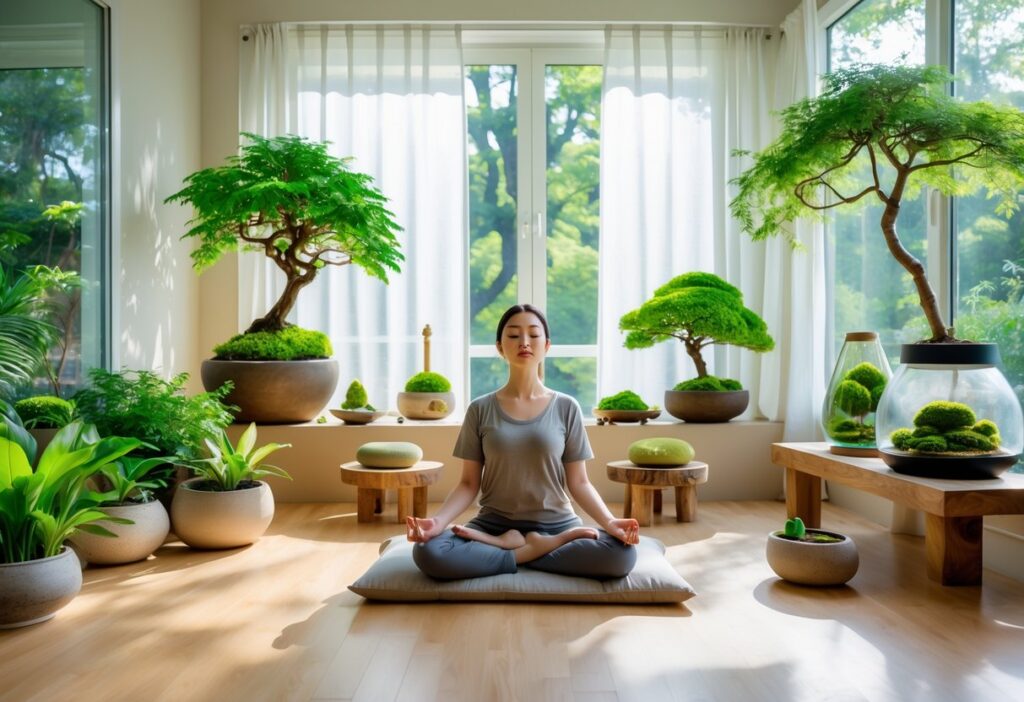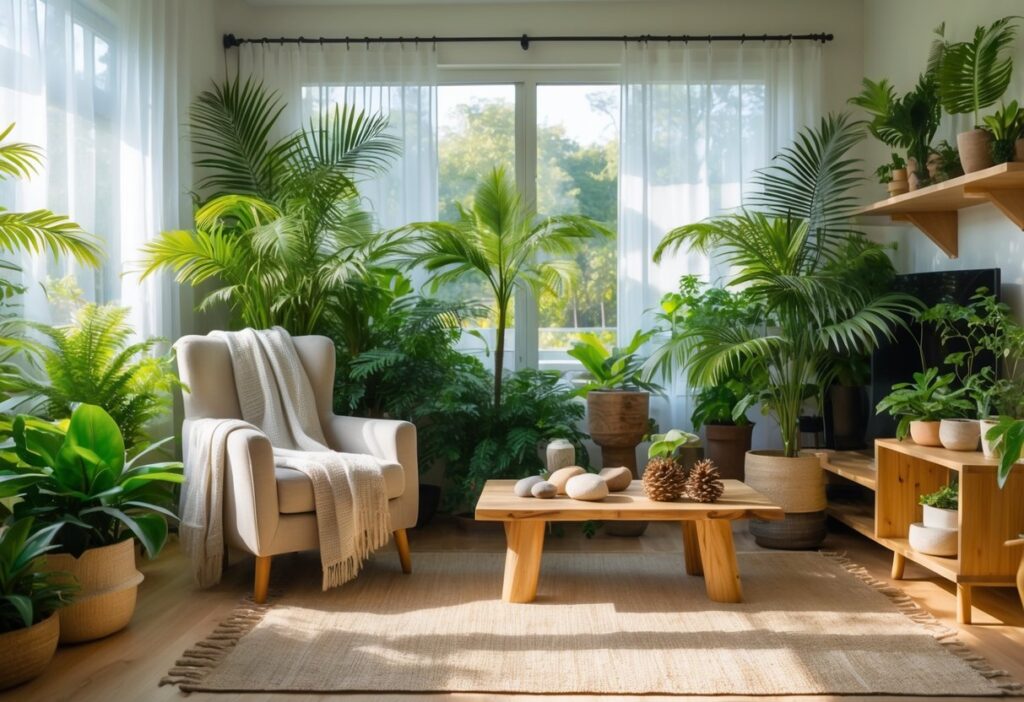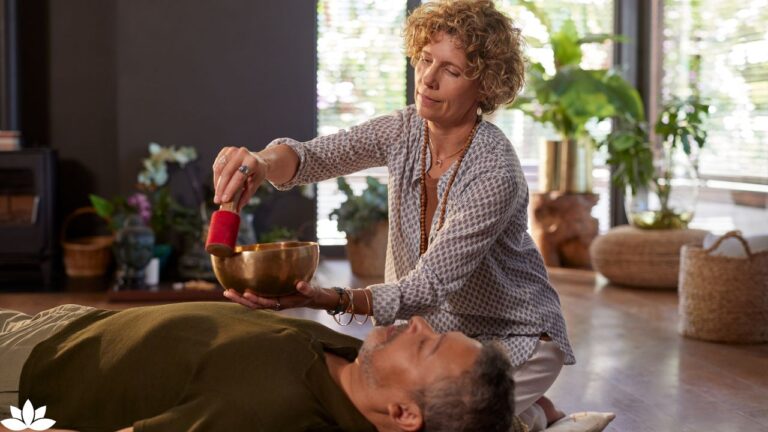Forest bathing is famous for melting away stress and boosting well-being by immersing you in nature. But honestly, you don’t have to trek out to the woods to get those benefits.
You can bring a bit of that forest magic home—think plants, earthy scents, and calming sounds right in your living room.

Making a small indoor spot that feels a bit like a forest can help you relax and feel more grounded. It’s surprisingly doable—just a few tweaks and you can tap into nature’s healing power, even if you’re stuck in the city or constantly busy.
Forest Bathing at Home: Recreating Nature’s Healing Power Indoors

It’s totally possible to bring the benefits of forest bathing indoors. All it takes are a few natural touches and some mindful habits.
These steps can help with stress, mental clarity, and maybe even give your immune system a nudge—without ever stepping outside. Knowing the science and tweaking your space just a bit can really shift your day-to-day well-being.
Understanding Shinrin-Yoku and Its Benefits
Shinrin-yoku, or forest bathing, is all about soaking up the forest vibe and connecting with nature on a deeper level. The practice can lower blood pressure, reduce stress, and even give your immune system a boost by increasing natural killer (NK) cell activity.
You don’t need a wild forest for this. Just having trees and plants around, and breathing in their natural oils (phytoncides), can help you feel less frazzled and more focused.
People say forest bathing supports mental health by easing anxiety and helping you unwind. Plus, it can improve your sleep and help you bounce back physically—pretty nice perks for something so simple.
The Science Behind Nature’s Healing Effects
Nature’s healing power works in a bunch of ways. When you’re around trees, your body responds to those plant chemicals—phytoncides—by ramping up immune activity.
Being in nature also dials down cortisol, your main stress hormone. That means lower blood pressure and a calmer mood.
Even just listening to birds or leaves rustling can slow your heart rate and quiet your mind. There’s research showing that even a few minutes with nature can sharpen your focus and help you feel more balanced emotionally.
Transitioning Forest Bathing Practices Indoors
If you want to try forest bathing at home, start by carving out a quiet, natural-feeling spot. Tune into your senses—what do you see, hear, and smell?
Try mindful walking in your garden or a peaceful room. Jotting down your observations in a journal can make the experience richer.
Invite someone to join you if you want—sometimes it’s nice to share a moment of calm. Turn off the screens, listen to some nature sounds, and even just ten or twenty minutes can make a difference.
Incorporating Elements of the Outdoors Into Your Space
To bring the outdoors in, add plants that give off phytoncides—like cedar, pine, or eucalyptus. Put them where you’ll actually see and breathe near them every day.
Try essential oils or candles with natural scents to mimic the forest. Layer in textures like wood, stone, or woven baskets for a more earthy vibe.
Play gentle nature sounds—water, birds, wind—just quietly in the background. Set up a cozy “nature corner” with soft lighting, greenery, and a comfy chair.
Air purifiers can help keep the air fresh, too. These little touches add up, making your space calmer and healthier, and letting you tap into nature’s benefits whenever you want.
Practical Strategies for Indoor Forest Bathing

Designing a peaceful space at home can really bring nature’s calming effects indoors. It’s about engaging your senses, grounding your body, and maybe even building a routine around it.
Designing a Nature-Inspired Indoor Sanctuary
Pick a quiet corner or room where you won’t be interrupted. Add lots of green plants—ferns or little trees are great—for that foresty feel.
Natural touches like wood furniture, stones, or even a small water feature can deepen your connection with nature. Soft, natural lighting or a few candles are way better than harsh overhead lights.
If you can, set up near a window with a view of the outdoors. Keep things simple and uncluttered, and lean into earth tones to help your mind shift out of “regular indoor mode.”
Engaging the Senses for a Meditative State
The heart of forest bathing is being present with your senses. Indoors, you can focus on little details—what do you see, hear, and smell?
Play nature sounds—birds, leaves, water. Use essential oils or natural incense like pine or eucalyptus if you like those scents.
Touch smooth stones, tree bark, or even soft leaves. Look closely at your plants—their colors, shapes, the way they move in the light. It’s a simple way to anchor yourself in the moment.
Grounding and Connection Techniques
Grounding is about feeling centered and connected, even inside. Try walking barefoot on a jute or bamboo rug, or if you’ve got a balcony or yard, step outside onto the grass for a bit.
Slow, deep breathing can do wonders for your nerves. You might even picture roots growing from your feet into the earth—sounds a bit odd, but it works for some people.
Holding a pine cone or a smooth stone while you sit can also help you feel more settled and calm.
So, is forest bathing at home as good as the real thing? Maybe not quite, but it’s honestly pretty close—and a lot more doable most days. With just a few changes, your home can become a little sanctuary where nature’s healing power is always within reach. Give it a try and see how you feel; you might be surprised by how much difference a few plants and a mindful pause can make.
Creating a Routine Forest Bathing Session at Home
Pick a time that works for you and try to stick with it. That way, your indoor forest bathing starts to feel like a natural part of the week—no big deal, just something you do. Sessions around 20 to 30 minutes seem to hit the sweet spot for most people.
When you’re ready, just settle in. Let your breath slow down a bit, and really pay attention to the air, the light, whatever’s around you. Sometimes I’ll stand barefoot or just focus on my breathing—nothing fancy, but it does the trick.
Before you wrap up, maybe take a minute or two to jot down what you noticed. Did your mood shift? Are your shoulders a little less tense? Even a short reflection can be surprisingly helpful.
Honestly, the simpler you keep it, the more likely you’ll actually stick with it. No need to overthink—just show up, notice, and see what happens.
It’s funny how a few minutes with intention can shift your whole day. Give it a try, and don’t worry if it’s not perfect. You might just find it’s what you needed.



